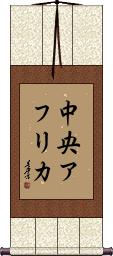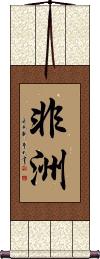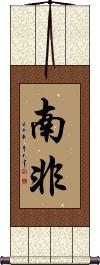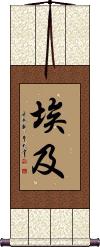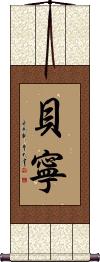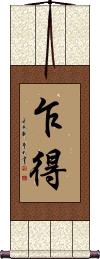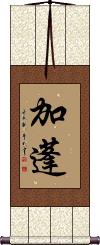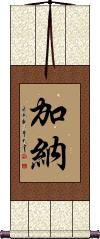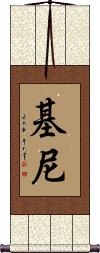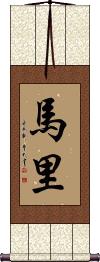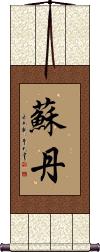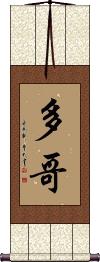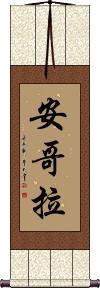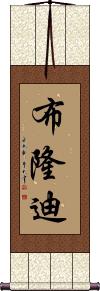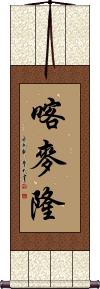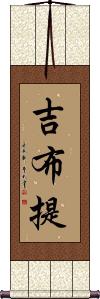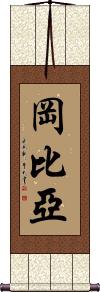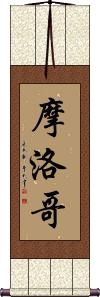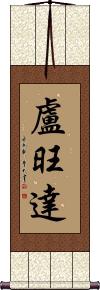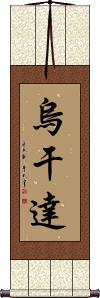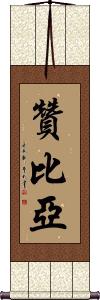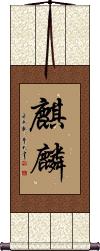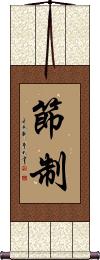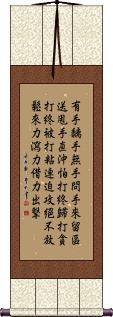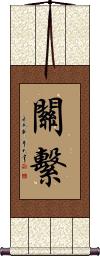Many custom options...
And formats...

The name Central Africa in Chinese / Japanese...
Buy a Central Africa calligraphy wall scroll here!
Personalize your custom “Central Africa” project by clicking the button next to your favorite “Central Africa” title below...
2. Africa
4. South Africa
5. Africa
6. South Africa
7. Egypt
8. Benin
9. Chad
10. Gabon
11. Ghana
12. Guinea
13. Mali
14. Sudan
15. Togo
16. Angola
17. Burundi
18. Cameroon
19. Comoros
20. Djibouti
21. Gambia
22. Kenya
23. Lesotho
24. Malawi
25. Morocco
26. Niger
27. Rwanda
28. Somalia
29. Uganda
30. Zambia
31. Anguilla
32. Botswana
33. Liberia
34. Mauritius
35. Mozambique
36. Namibia
37. Nigeria
38. Senegal
39. Sierra Leone
40. Swaziland
41. Tanzania
42. Zimbabwe
43. Algeria
44. Ethiopia
45. Madagascar
46. Mauritania
47. Seychelles
48. Falkland Islands
49. CIA
50. Kirin / Giraffe / Mythical Creature
51. Temperance
53. Guanxi
Central Africa
Africa
Central African Republic
This is the Chinese name for the country of the Central African Republic.
See Also: Africa
South Africa
Africa
South Africa
Egypt
Benin
Chad
Gabon
Ghana
Guinea
Mali
Sudan
Togo
Angola
Burundi
Cameroon
Comoros
Djibouti
Gambia
Kenya
Lesotho
Malawi
Morocco
Niger
Rwanda
Somalia
Uganda
Zambia
Anguilla
This is the Chinese name for Anguilla (overseas territory of the United Kingdom).
See Also: Africa
Botswana
Liberia
Mauritius
Mozambique
Namibia
Nigeria
Senegal
Sierra Leone
Swaziland
Tanzania
Zimbabwe
Algeria
Ethiopia
Madagascar
Mauritania
Seychelles
Falkland Islands
This is the Chinese name for the Falkland Islands (overseas territory of the United Kingdom).
See Also: Great Britain | United Kingdom | Africa
Kirin / Giraffe / Mythical Creature
麒麟 is the title of a mythical beast of Asia.
The animal is thought to be related to the giraffe, and in some ways, it is a giraffe. However, it is often depicted with the horns of a dragon or deer and sometimes with the body like a horse, but many variations exist.
In Japanese, it is pronounced “Kirin” as in “Kirin Ichiban” beer.
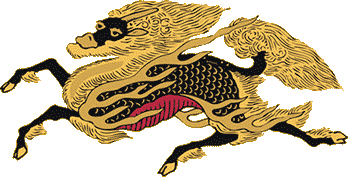
Notes:
1. This is sometimes spelled as “kylin.”
2. In Japanese, this is the only Kanji word for giraffe. Therefore in Japan, this word needs context to know whether you are talking about the mythical creature or the long-necked giraffe of Africa.
3. Apparently, this was the first word used for regular giraffes in China (some were brought from Africa to China during the Ming Dynasty - probably around the year 1400). Though the mythical creature may have existed before, the name “qilin” was given to the “new giraffe.” This is because, more than 600 years ago, giraffes somewhat matched the mythical creature's description when Chinese people saw them for the first time. Later, to avoid such an ambiguous title, a three-character word was devised to mean a “giraffe of Africa.” The characters for “qilin” shown here are only for the mythological version in modern Chinese.
4. More information about the qilin / kirin from Wikipedia.
5. This creature is sometimes translated as the “Chinese Unicorn,” although it is generally portrayed with two horns. I think this is done more for the fantasy aspect of the unicorn and because most westerners don't know what a qilin or kirin is (this avoids a long explanation by the translator).
6. In Korean, this can mean kirin or simply giraffe (usually, the mythological creature is what they would think of when seeing these characters alone on a wall scroll).
Temperance
In short, 節制 or temperance is knowing when to say “when.”
Temperance is the practice of moderation and restraint (in fact, this Asian word is often translated as moderation or restraint).
It was one of the five tenets held to be vital to society in Hellenic culture. It is also one of the Four Cardinal Virtues considered central to Christian behavior by the Catholic Church.
Note: Also considered to be one of the Seven Heavenly Virtues.
Wing Chun Fist Maxims (Part 1)
A customer asked me to split these Wing Chun maxims into two parts, so he could order a couplet. I thought this was a good idea, so it's been added here.
1 有手黐手,無手問手
2 來留區送, 甩手直沖
3 怕打終歸打, 貪打終被打
4 粘連迫攻, 絕不放鬆
5 來力瀉力, 借力出擊
A couplet is a set of two wall scrolls that start and finish one phrase or idea. Often, couplets are hung with the first wall scroll on the right side, and the second on the left side of a doorway or entrance. The order in Chinese is right-to-left, so that's why the first wall scroll goes on the right as you face the door.
Of course, couplets can also be hung together on a wall. Often they can be hung to flank an altar, or table with incense, or even flanking a larger central wall scroll. See an example here from the home of Confucius
Be sure to order both parts 1 and 2 together. One without the other is like Eve without Adam.
Guanxi
The Chinese Concept of Relationship and Exchange of Favors
The dictionary definition is:
Relations/relationship, to concern, to affect, to have to do with, or connection.
But there's more to it...
In China, the relationship that you have with certain people can open doors for you. Having guanxi with someone also means they would never defraud you but are honor-bound to treat you fairly (of course, this goes both ways). Sometimes it is suggested that guanxi is the exchange of favors. 關繫 / 関繫 / 關係 is more about having a relationship that allows you to ask for and expect favors without shame.
There is no concept in western culture that exactly matches guanxi, but perhaps having a social or professional network is similar.
Note that there are some variations common within Chinese, Japanese Kanji, and Korean Hanja for this word... Japanese tend to use a Chinese alternate form as shown to the right for
Japanese tend to use a Chinese alternate form as shown to the right for
the first character.
 There's also another alternate form of that first character (currently used as the official Simplified form in mainland China) which looks like the character shown to the right. It's basically the central radical of the alternate version shown above but without the “door radical” around it. In more free-flowing calligraphy styles, this version would be the likely choice for a calligrapher.
There's also another alternate form of that first character (currently used as the official Simplified form in mainland China) which looks like the character shown to the right. It's basically the central radical of the alternate version shown above but without the “door radical” around it. In more free-flowing calligraphy styles, this version would be the likely choice for a calligrapher.
![]() In Modern Japanese, they use the character shown to the right.
In Modern Japanese, they use the character shown to the right.
They also tend to use this same form in Korean Hanja (I've only checked this word in my Korean dictionary, but it has not been confirmed by a translator's review).
![]() If that was not confusing enough, there is another alternate form of that second character. See right.
If that was not confusing enough, there is another alternate form of that second character. See right.
An Asian calligrapher of any nationality may use these forms at their discretion. However, They would tend to stick to the most common form used in their respective languages.
If you have any preference on any of these issues, please give us a special note with your order, and we'll make sure it's done the way you want.
Mountain Travels Poem by Dumu
This poem was written almost 1200 years ago during the Tang dynasty.
It depicts traveling up a place known as Cold Mountain, where some hearty people have built their homes. The traveler is overwhelmed by the beauty of the turning leaves of the maple forest that surrounds him just as night overtakes the day, and darkness prevails. His heart implores him to stop, and take in all of the beauty around him.
First, before you get to the full translation, I must tell you that Chinese poetry is a lot different than what we have in the west. Chinese words simply don't rhyme in the same way that English or other western languages do. Chinese poetry depends on rhythm and a certain beat of repeated numbers of characters.
I have done my best to translate this poem keeping a certain feel of the original poet. But some of the original beauty of the poem in its original Chinese will be lost in translation.
Far away on Cold Mountain, a stone path leads upwards.
Among white clouds, people's homes reside.
Stopping my carriage I must, as to admire the maple forest at nights fall.
In awe of autumn leaves showing more red than even flowers of early spring.
Hopefully, this poem will remind you to stop, and “take it all in” as you travel through life.
The poet's name is “Du Mu” in Chinese that is: ![]()
![]() .
.
The title of the poem, “Mountain Travels” is: ![]()
![]()
You can have the title, poet's name, and even “Tang Dynasty” written as an inscription on your custom wall scroll if you like.
More about the poet:
Dumu lived from 803-852 AD and was a leading Chinese poet during the later part of the Tang dynasty.
He was born in Chang'an, a city in central China and the former capital of the ancient Chinese empire in 221-206 BC. In present-day China, his birthplace is currently known as Xi'an, the home of the Terracotta Soldiers.
He was awarded his Jinshi degree (an exam administered by the emperor's court which leads to becoming an official of the court) at the age of 25 and went on to hold many official positions over the years. However, he never achieved a high rank, apparently because of some disputes between various factions, and his family's criticism of the government. His last post in the court was his appointment to the office of Secretariat Drafter.
During his life, he wrote scores of narrative poems, as well as a commentary on the Art of War and many letters of advice to high officials.
His poems were often very realistic and often depicted everyday life. He wrote poems about everything, from drinking beer in a tavern to weepy poems about lost love.
The thing that strikes you most is the fact even after 1200 years, not much has changed about the beauty of nature, toils, and troubles of love and beer drinking.
The following table may be helpful for those studying Chinese or Japanese...
| Title | Characters | Romaji (Romanized Japanese) | Various forms of Romanized Chinese | |
| Central Africa | 中央アフリカ | chuuou a fu ri ka chuuouafurika chuo a fu ri ka | ||
| Africa | 非洲 | fēi zhōu / fei1 zhou1 / fei zhou / feizhou | fei chou / feichou | |
| Central African Republic | 中非共和國 中非共和国 | zhōng fēi gòng hé guó zhong1 fei1 gong4 he2 guo2 zhong fei gong he guo zhongfeigongheguo | chung fei kung ho kuo chungfeikunghokuo |
|
| South Africa | 南非 | nán fēi / nan2 fei1 / nan fei / nanfei | ||
| Africa | 阿非利加 | ā fēi lì jiā a1 fei1 li4 jia1 a fei li jia afeilijia | a fei li chia afeilichia |
|
| South Africa | 南アフリカ | minami a fu ri ka minamiafurika | ||
| Egypt | 埃及 | āi jí / ai1 ji2 / ai ji / aiji | ai chi / aichi | |
| Benin | 貝寧 贝宁 | bèi níng / bei4 ning2 / bei ning / beining | pei ning / peining | |
| Chad | 乍得 | zhà dé / zha4 de2 / zha de / zhade | cha te / chate | |
| Gabon | 加蓬 | jiā péng / jia1 peng2 / jia peng / jiapeng | chia p`eng / chiapeng / chia peng | |
| Ghana | 加納 加纳 | jiā nà / jia1 na4 / jia na / jiana | chia na / chiana | |
| Guinea | 基尼 | jī ní / ji1 ni2 / ji ni / jini | chi ni / chini | |
| Mali | 馬里 马里 | mǎ lǐ / ma3 li3 / ma li / mali | ||
| Sudan | 蘇丹 苏丹 | sū dān / su1 dan1 / su dan / sudan | su tan / sutan | |
| Togo | 多哥 | duō gē / duo1 ge1 / duo ge / duoge | to ko / toko | |
| Angola | 安哥拉 | ān gē lā an1 ge1 la1 an ge la angela | an ko la ankola |
|
| Burundi | 布隆迪 | bù lóng dí bu4 long2 di2 bu long di bulongdi | pu lung ti pulungti |
|
| Cameroon | 喀麥隆 喀麦隆 | kā mài lóng ka1 mai4 long2 ka mai long kamailong | k`a mai lung kamailung ka mai lung |
|
| Comoros | 科摩羅 科摩罗 | kē mó luó ke1 mo2 luo2 ke mo luo kemoluo | k`o mo lo komolo ko mo lo |
|
| Djibouti | 吉布提 | jí bù tí ji2 bu4 ti2 ji bu ti jibuti | chi pu t`i chiputi chi pu ti |
|
| Gambia | 岡比亞 冈比亚 | gāng bǐ yà gang1 bi3 ya4 gang bi ya gangbiya | kang pi ya kangpiya |
|
| Kenya | 肯尼亞 肯尼亚 | kěn ní yà ken3 ni2 ya4 ken ni ya kenniya | k`en ni ya kenniya ken ni ya |
|
| Lesotho | 萊索托 莱索托 | lái suǒ tuō lai2 suo3 tuo1 lai suo tuo laisuotuo | lai so t`o laisoto lai so to |
|
| Malawi | 馬拉維 马拉维 | mǎ lā wéi ma3 la1 wei2 ma la wei malawei | ||
| Morocco | 摩洛哥 | mó luò gē mo2 luo4 ge1 mo luo ge moluoge | mo lo ko moloko |
|
| Niger | 尼日爾 尼日尔 | ní rì ěr ni2 ri4 er3 ni ri er nirier | ni jih erh nijiherh |
|
| Rwanda | 盧旺達 卢旺达 | lú wàng dá lu2 wang4 da2 lu wang da luwangda | lu wang ta luwangta |
|
| Somalia | 索馬里 索马里 | suǒ mǎ lǐ suo3 ma3 li3 suo ma li suomali | so ma li somali |
|
| Uganda | 烏干達 乌干达 | wū gān dá wu1 gan1 da2 wu gan da wuganda | wu kan ta wukanta |
|
| Zambia | 贊比亞 赞比亚 | zàn bǐ yà zan4 bi3 ya4 zan bi ya zanbiya | tsan pi ya tsanpiya |
|
| Anguilla | 安圭拉島 安圭拉岛 | ān guī lā dǎo an1 gui1 la1 dao3 an gui la dao anguiladao | an kuei la tao ankueilatao |
|
| Botswana | 博茨瓦納 博茨瓦纳 | bó cí wǎ nà bo2 ci2 wa3 na4 bo ci wa na bociwana | po tz`u wa na potzuwana po tzu wa na |
|
| Liberia | 利比里亞 利比里亚 | lì bǐ lǐ yà li4 bi3 li3 ya4 li bi li ya libiliya | li pi li ya lipiliya |
|
| Mauritius | 毛里求斯 | máo lǐ qiú sī mao2 li3 qiu2 si1 mao li qiu si maoliqiusi | mao li ch`iu ssu maolichiussu mao li chiu ssu |
|
| Mozambique | 莫桑比克 | mò sāng bǐ kè mo4 sang1 bi3 ke4 mo sang bi ke mosangbike | mo sang pi k`o mosangpiko mo sang pi ko |
|
| Namibia | 納米比亞 纳米比亚 | nà mǐ bǐ yà na4 mi3 bi3 ya4 na mi bi ya namibiya | na mi pi ya namipiya |
|
| Nigeria | 尼日利亞 尼日利亚 | ní rì lì yà ni2 ri4 li4 ya4 ni ri li ya niriliya | ni jih li ya nijihliya |
|
| Senegal | 塞內加爾 塞内加尔 | sāi nèi jiā ěr sai1 nei4 jia1 er3 sai nei jia er saineijiaer | sai nei chia erh saineichiaerh |
|
| Sierra Leone | 塞拉利昂 | sài lā lì áng sai4 la1 li4 ang2 sai la li ang sailaliang | ||
| Swaziland | 斯威士蘭 斯威士兰 | sī wēi shì lán si1 wei1 shi4 lan2 si wei shi lan siweishilan | ssu wei shih lan ssuweishihlan |
|
| Tanzania | 坦桑尼亞 坦桑尼亚 | tǎn sāng ní yà tan3 sang1 ni2 ya4 tan sang ni ya tansangniya | t`an sang ni ya tansangniya tan sang ni ya |
|
| Zimbabwe | 津巴布韋 津巴布韦 | jīn bā bù wéi jin1 ba1 bu4 wei2 jin ba bu wei jinbabuwei | chin pa pu wei chinpapuwei |
|
| Algeria | 阿爾及利亞 阿尔及利亚 | ā ěr jí lì yà a1 er3 ji2 li4 ya4 a er ji li ya aerjiliya | a erh chi li ya aerhchiliya |
|
| Ethiopia | 埃塞俄比亞 埃塞俄比亚 | āi sài é bǐ yà ai1 sai4 e2 bi3 ya4 ai sai e bi ya aisaiebiya | ai sai o pi ya aisaiopiya |
|
| Madagascar | 馬達加斯加 马达加斯加 | mǎ dá jiā sī jiā ma3 da2 jia1 si1 jia1 ma da jia si jia madajiasijia | ma ta chia ssu chia matachiassuchia |
|
| Mauritania | 毛里塔尼亞 毛里塔尼亚 | máo lǐ tǎ ní yà mao2 li3 ta3 ni2 ya4 mao li ta ni ya maolitaniya | mao li t`a ni ya maolitaniya mao li ta ni ya |
|
| Seychelles | 塞舌爾群島 塞舌尔群岛 | sài shé ěr qún dǎo sai4 she2 er3 qun2 dao3 sai she er qun dao saisheerqundao | sai she erh ch`ün tao saisheerhchüntao sai she erh chün tao |
|
| Falkland Islands | 福克蘭群島 福克兰群岛 | fú kè lán qún dǎo fu2 ke4 lan2 qun2 dao3 fu ke lan qun dao fukelanqundao | fu k`o lan ch`ün tao fukolanchüntao fu ko lan chün tao |
|
| CIA | 中央情報局 中央情报局 | chuuoujouhoukyoku / chuojohokyoku chuojohokyoku / chuojohokyoku | zhōng yāng qíng bào jú zhong1 yang1 qing2 bao4 ju2 zhong yang qing bao ju zhongyangqingbaoju | chung yang ch`ing pao chü chungyangchingpaochü chung yang ching pao chü |
| Kirin Giraffe Mythical Creature | 麒麟 | kirin | qí lǐn / qi2 lin3 / qi lin / qilin | ch`i lin / chilin / chi lin |
| Temperance | 節制 节制 | sessei / sesei | jié zhì / jie2 zhi4 / jie zhi / jiezhi | chieh chih / chiehchih |
| Wing Chun Fist Maxims (Part 1) | 有手黐手無手問手來留區送甩手直沖怕打終歸打貪打終被打粘連迫攻絕不放鬆來力瀉力借力出擊 有手黐手无手问手来留区送甩手直冲怕打终归打贪打终被打粘连迫攻绝不放松来力泻力借力出击 | |||
| Guanxi | 關繫 / 関繫 / 關係 关系 / 関係 | kankei | guān xì / guan1 xi4 / guan xi / guanxi | kuan hsi / kuanhsi |
| Mountain Travels Poem by Dumu | 遠上寒山石徑斜白雲生處有人家停車坐愛楓林晚霜葉紅於二月花 远上寒山石径斜白云生处有人家停车坐爱枫林晚霜叶红于二月花 | yuǎn shàng hán shān shí jìng xiá bái yún shēng chù yǒu rén jiā tíng chē zuò ài fēng lín wǎn shuàng yè hóng yú èr yuè huā yuan3 shang4 han2 shan1 shi2 jing4 xia2 bai2 yun2 sheng1 chu4 you3 ren2 jia1 ting2 che1 zuo4 ai4 feng1 lin2 wan3 shuang4 ye4 hong2 yu2 er4 yue4 hua1 yuan shang han shan shi jing xia bai yun sheng chu you ren jia ting che zuo ai feng lin wan shuang ye hong yu er yue hua | yüan shang han shan shih ching hsia pai yün sheng ch`u yu jen chia t`ing ch`e tso ai feng lin wan shuang yeh hung yü erh yüeh hua yüan shang han shan shih ching hsia pai yün sheng chu yu jen chia ting che tso ai feng lin wan shuang yeh hung yü erh yüeh hua |
|
| In some entries above you will see that characters have different versions above and below a line. In these cases, the characters above the line are Traditional Chinese, while the ones below are Simplified Chinese. | ||||
Successful Chinese Character and Japanese Kanji calligraphy searches within the last few hours...
